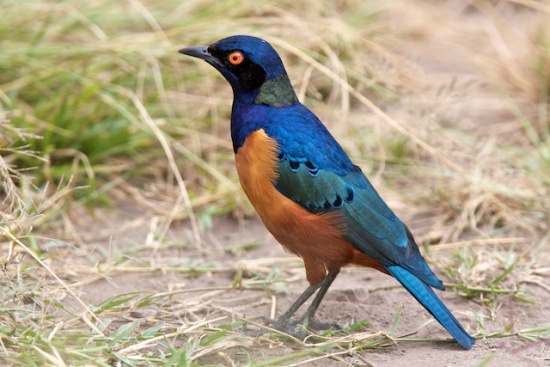m (→Similar species: typo) |
(Imp size. C/right. Basic update. References updated) |
||
| (One intermediate revision by the same user not shown) | |||
| Line 1: | Line 1: | ||
| − | [[Image:Hildebrandt s Starling 435.jpg|thumb|550px|right|Photo by {{user|GordonH|GordonH}}<br />Ngorongoro Crater, [[Tanzania]], June 2010]] | + | [[Image:Hildebrandt s Starling 435.jpg|thumb|550px|right|Photo © by {{user|GordonH|GordonH}}<br />Ngorongoro Crater, [[Tanzania]], June 2010]] |
;[[:Category:Lamprotornis|Lamprotornis]] hildebrandti | ;[[:Category:Lamprotornis|Lamprotornis]] hildebrandti | ||
==Identification== | ==Identification== | ||
| − | 18cm | + | 18cm (7 in) |
* Dark glossy blue forehead and crown | * Dark glossy blue forehead and crown | ||
* Bronze-green half-collar on nape | * Bronze-green half-collar on nape | ||
| Line 8: | Line 8: | ||
* Bronze-green wing with dark spots | * Bronze-green wing with dark spots | ||
* Glossy blue-green tail | * Glossy blue-green tail | ||
| − | * Dark glossy purple chin, throat, ear-coverts and upper breast | + | * Dark glossy purple chin, throat, ear-[[Topography#General Anatomy|coverts]] and upper breast |
* Light orange-buff lower breast and upper belly | * Light orange-buff lower breast and upper belly | ||
* Rufous lower belly, flanks, thighs and undertail-coverts | * Rufous lower belly, flanks, thighs and undertail-coverts | ||
| Line 21: | Line 21: | ||
Fairly common to uncommon in its range. | Fairly common to uncommon in its range. | ||
==Taxonomy== | ==Taxonomy== | ||
| − | This is a [[Dictionary_M- | + | This is a [[Dictionary_M-O#M|monotypic]] species.<br /> |
| − | Has been considered conspecific with [[Shelley's Starling]] and both have been included in a superspecies with [[Chestnut-bellied Starling]]. | + | Has been considered [[Dictionary_A-C#C|conspecific]] with [[Shelley's Starling]] and both have been included in a superspecies with [[Chestnut-bellied Starling]]. |
| + | |||
==Habitat== | ==Habitat== | ||
Open bush and open woodland. Also around cattle and settlements. Occurs at 500 - 2200m. | Open bush and open woodland. Also around cattle and settlements. Occurs at 500 - 2200m. | ||
==Behaviour== | ==Behaviour== | ||
| + | ====Diet==== | ||
Feeds mainly on insects (like beetles and grasshoppers), may also take fruit.<br /> | Feeds mainly on insects (like beetles and grasshoppers), may also take fruit.<br /> | ||
| − | Forages in pairs or small flocks on the ground. Feeds often together with [[Superb Starling]], [[Greater Blue-eared Glossy-Starling]] or [[Wattled Starling]]. | + | Forages in pairs or small flocks on the ground. Feeds often together with [[Superb Starling]], [[Greater Blue-eared Glossy-Starling]] or [[Wattled Starling]]. |
| − | Breeding season from March to May and October to December, May to July on Laikipia Plateau in Kenya. Co-operative breeding reported. The nest is placed in a tree hole or in an artificial hole (in a lamppost or telegraphe pole). Lays 3 - 4 eggs. Brood parasitism by [[Great Spotted Cuckoo]] reported. | + | ====Breeding==== |
| + | Breeding season from March to May and October to December, May to July on Laikipia Plateau in Kenya. Co-operative breeding reported. The nest is placed in a tree hole or in an artificial hole (in a lamppost or telegraphe pole). Lays 3 - 4 eggs. Brood parasitism by [[Great Spotted Cuckoo]] reported. | ||
| + | ====Movements==== | ||
Presumably a resident species. | Presumably a resident species. | ||
==References== | ==References== | ||
| − | #{{Ref- | + | #{{Ref-Clements6thAug18}}#{{Ref-HBWVol14}} |
{{ref}} | {{ref}} | ||
==External Links== | ==External Links== | ||
Latest revision as of 00:34, 21 September 2018
- Lamprotornis hildebrandti
Identification
18cm (7 in)
- Dark glossy blue forehead and crown
- Bronze-green half-collar on nape
- Dark glossy blue upperparts
- Bronze-green wing with dark spots
- Glossy blue-green tail
- Dark glossy purple chin, throat, ear-coverts and upper breast
- Light orange-buff lower breast and upper belly
- Rufous lower belly, flanks, thighs and undertail-coverts
- Orange-red eye
- Black bill and legs
Sexes similar. Juveniles have dull charcoal-grey upperparts and pale chestnut-brown underparts, a brown eye, a dull yellow eyering and a dull orange-yellow bill.
Similar species
Distinguished from commoner Superb Starling by lack of white breast band and in having a paler breast than the belly. Shelley's Starling has much darker rufous underparts.
Distribution
From north-central Kenya south to northern Tanzania.
Fairly common to uncommon in its range.
Taxonomy
This is a monotypic species.
Has been considered conspecific with Shelley's Starling and both have been included in a superspecies with Chestnut-bellied Starling.
Habitat
Open bush and open woodland. Also around cattle and settlements. Occurs at 500 - 2200m.
Behaviour
Diet
Feeds mainly on insects (like beetles and grasshoppers), may also take fruit.
Forages in pairs or small flocks on the ground. Feeds often together with Superb Starling, Greater Blue-eared Glossy-Starling or Wattled Starling.
Breeding
Breeding season from March to May and October to December, May to July on Laikipia Plateau in Kenya. Co-operative breeding reported. The nest is placed in a tree hole or in an artificial hole (in a lamppost or telegraphe pole). Lays 3 - 4 eggs. Brood parasitism by Great Spotted Cuckoo reported.
Movements
Presumably a resident species.
References
- Clements, J. F., T. S. Schulenberg, M. J. Iliff, D. Roberson, T. A. Fredericks, B. L. Sullivan, and C. L. Wood. 2018. The eBird/Clements checklist of birds of the world: v2018. Downloaded from http://www.birds.cornell.edu/clementschecklist/download/
- Del Hoyo, J, A Elliott, and D Christie, eds. 2009. Handbook of the Birds of the World. Volume 14: Bush-shrikes to Old World Sparrows. Barcelona: Lynx Edicions. ISBN 978-8496553507
Recommended Citation
- BirdForum Opus contributors. (2024) Hildebrandt's Starling. In: BirdForum, the forum for wild birds and birding. Retrieved 29 April 2024 from https://www.birdforum.net/opus/Hildebrandt%27s_Starling




